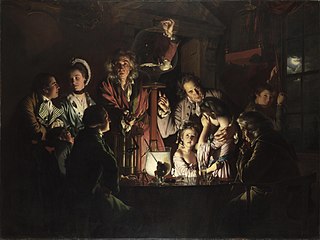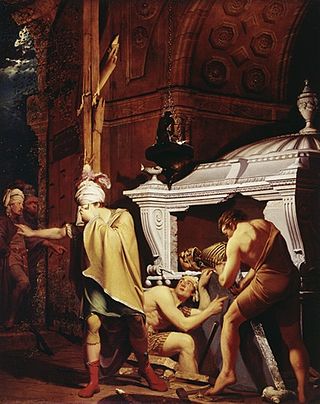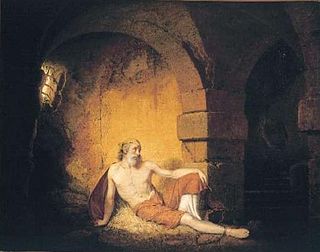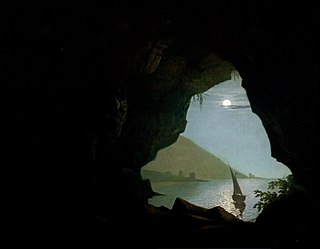
Thomas Banks was an important 18th-century English sculptor.

Henry Fuseli was a Swiss painter, draughtsman, and writer on art who spent much of his life in Britain. Many of his works depict supernatural experiences, such as The Nightmare. He painted works for John Boydell's Shakespeare Gallery and created his own "Milton Gallery". He held the posts of Professor of Painting and Keeper at the Royal Academy. His style had a considerable influence on many younger British artists, including William Blake.

Joseph Wright, styled Joseph Wright of Derby, was an English landscape and portrait painter. He has been acclaimed as "the first professional painter to express the spirit of the Industrial Revolution".

Derby Museum and Art Gallery is a museum and art gallery in Derby, England. It was established in 1879, along with Derby Central Library, in a new building designed by Richard Knill Freeman and given to Derby by Michael Thomas Bass. The collection includes a gallery displaying many paintings by Joseph Wright of Derby; there is also a large display of Royal Crown Derby and other porcelain from Derby and the surrounding area. Further displays include archaeology, natural history, geology, military collections and world cultures. The Art Gallery was opened in 1882.

Louise Ingram Rayner was a British watercolour artist.

An Experiment on a Bird in the Air Pump is a 1768 oil-on-canvas painting by Joseph Wright of Derby, one of a number of candlelit scenes that Wright painted during the 1760s. The painting departed from convention of the time by depicting a scientific subject in the reverential manner formerly reserved for scenes of historical or religious significance. Wright was intimately involved in depicting the Industrial Revolution and the scientific advances of the Enlightenment. While his paintings were recognized as exceptional by his contemporaries, his provincial status and choice of subjects meant the style was never widely imitated. The picture has been owned by the National Gallery in London since 1863 and is regarded as a masterpiece of British art.

A Philosopher Lecturing on the Orrery, or the full title, A Philosopher giving that Lecture on the Orrery in which a lamp is put in place of the Sun, is a 1766 painting by Joseph Wright of Derby depicting a lecturer giving a demonstration of an orrery – a mechanical model of the solar system – to a small audience. It is now in the Derby Museum and Art Gallery The painting preceded his similar An Experiment on a Bird in the Air Pump.

Julius Caesar Ibbetson was a British 18th-century landscape and watercolour painter.

The Boydell Shakespeare Gallery in London, England, was the first stage of a three-part project initiated in November 1786 by engraver and publisher John Boydell in an effort to foster a school of British history painting. In addition to the establishment of the gallery, Boydell planned to produce an illustrated edition of William Shakespeare's plays and a folio of prints based upon a series of paintings by different contemporary painters. During the 1790s the London gallery that showed the original paintings emerged as the project's most popular element.

Virgil's Tomb is the title of at least three paintings completed by Joseph Wright of Derby between 1779 and 1785.

Samuel A. Rayner was an English landscape artist, known for his paintings of buildings and their interiors, including abbeys, churches and old mansions. He achieved the distinction of having a work accepted for exhibition at the Royal Academy at the age of 15. His wife, Ann Rayner, was an engraver on Ashford Black Marble and six of their children went on to be professional artists.

Indian Widow is a painting by Joseph Wright of Derby, completed in late 1783 or early 1784 and first shown in his solo exhibition in London in 1785. The painting is since 1961 in the collection of Derby Museum and Art Gallery.

Miravan Breaking Open the Tomb of his Ancestors is a painting by Joseph Wright of Derby originally completed in 1772.

Earthstopper on the Banks of the Derwent is a painting by Joseph Wright of Derby originally completed in 1773. The scene shows a man digging at nighttime beside the River Derwent in Derbyshire.

The Derby Exhibition of 1839 was the first exhibition in Derby. It was held at the town's Mechanics' Institute, which later became known as Albert Hall. The exhibition was in line with the founding values of the Institute, which were to extend the spread of knowledge among the people of Derby. The institute had organized a wide range of events since 1825, including lectures, concerts, and displays. The exhibition followed the first such organised by Manchester Mechanics Institute in 1837 and Derby's was one of several that were organised that year in English industrial towns and cities. Derby's exhibition had a profound impact and was one of the factors leading to the foundation of the Museum and Library in 1878. Derby Museum and Art Gallery, which is next door to what was the Mechanics Institute building, now holds many of the objects from the exhibition.

The Captive, from Sterne is a painting by Joseph Wright of Derby completed in 1774 and now in the National Gallery of Canada. Sterne's Captive, first exhibited by the artist in 1778, is a similar painting by Wright in the Derby Museum and Art Gallery. The latter painting resulted in a rare engraving, as its purchaser commissioned a print run of only twenty copies before the copper printing plate was destroyed. In 2012, Derby Museum commissioned another Captive painting from Emma Tooth.

Grotto in the Gulf of Salerno is the subject of at least four paintings completed by Joseph Wright of Derby following his visit there in 1774. The paintings show the different lighting at different times of the day.
Samuel Middiman (1750–1831) was an English engraver.

Two Girls Dressing a Kitten by Candlelight is a "fancy painting" by Joseph Wright of Derby (1734–1797). The painting is displayed at the Kenwood House Public Museum, located in the London Hampstead area.

Titania and Bottom is an oil painting by the Anglo-Swiss painter Henry Fuseli. It dates to around 1790 and is displayed at Tate Britain in London. It was commissioned for the Boydell Shakespeare Gallery and depicts a scene from A Midsummer Night's Dream by William Shakespeare.




















